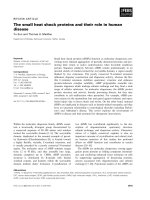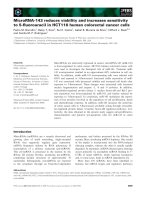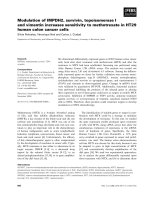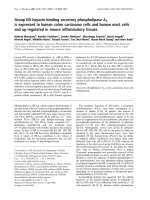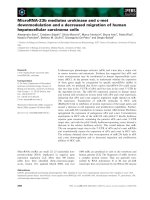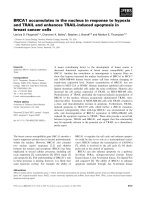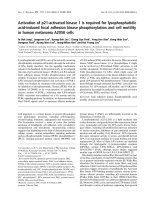IL-1β induces IL-6 production and increases invasiveness and estrogen-independent growth in a TG2-dependent manner in human breast cancer cells
Bạn đang xem bản rút gọn của tài liệu. Xem và tải ngay bản đầy đủ của tài liệu tại đây (3.34 MB, 11 trang )
Oh et al. BMC Cancer (2016) 16:724
DOI 10.1186/s12885-016-2746-7
RESEARCH ARTICLE
Open Access
IL-1β induces IL-6 production and increases
invasiveness and estrogen-independent
growth in a TG2-dependent manner in
human breast cancer cells
Keunhee Oh1,2*†, Ok-Young Lee1†, Yeonju Park1, Myung Won Seo1 and Dong-Sup Lee1*
Abstract
Background: We previously reported that IL-6 and transglutaminase 2 (TG2) were expressed in more aggressive
basal-like breast cancer cells, and TG2 and IL-6 expression gave these cells stem-cell-like phenotypes, increased
invasive ability, and increased metastatic potential. In the present study, the underlying mechanism by which IL-6
production is induced in luminal-type breast cancer cells was evaluated, and TG2 overexpression, IL-1β stimulation,
and IL-6 expression were found to give cancerous cells a hormone-independent phenotype.
Methods: Luminal-type breast cancer cells (MCF7 cells) were stably transfected with TG2. To evaluate the requirement
for IL-6 neogenesis, MCF7 cells were stimulated with various cytokines. To evaluate tumorigenesis, cancer cells were
grown in a three-dimensional culture system and grafted into the mammary fat pads of NOD/scid/IL-2Rγ−/− mice.
Results: IL-1β induced IL-6 production in TG2-expressing MCF7 cells through an NF-kB-, PI3K-, and JNK-dependent
mechanism. IL-1β increased stem-cell-like phenotypes, invasiveness, survival in a three-dimensional culture model, and
estrogen-independent tumor growth of TG2-expressing MCF7 cells, which was attenuated by either anti-IL-6 or anti-IL-1β
antibody treatment.
Conclusion: Within the inflammatory tumor microenvironment, IL-1β increases luminal-type breast cancer cell
aggressiveness by stimulating IL-6 production through a TG2-dependent mechanism.
Keywords: Luminal-type breast cancer cell, Hormone-independent, IL-1β, IL-6, Transglutaminase 2
Abbreviations: 2D, Two-dimensional; 3D, Three-dimensional; ANOVA, Two-way analysis of variance;
BLM, Bleomycin; CSC, Cancer stem cell; DMEM, Dulbecco’s Modified Eagle Medium; EMT, Epithelial-mesenchymal
transition; ER, Estrogen receptor; FBS, Fetal bovine serum; IL-6, Interleukin-6; KD, Knockdown;
LPS, Lipopolysaccharide; MDSC, Myeloid-derived suppressor cells; M-MLV, Moloney murine leukemia virus;
NOG, NOD/scid/IL-2Rγ−/−; Pam, Pam3Cys; PGN, Peptidoglycan; P-JNK1, Phospho-JNK1; TG2, Transglutaminase 2;
TIMP, Tissue inhibitor of metalloproteinase
* Correspondence: ;
†
Equal contributors
1
Laboratory of Immunology and Cancer Biology, Department of Biomedical
Sciences, Transplantation Research Institute, Seoul National University College
of Medicine, 103 Daehak-ro Jongno-gu, Seoul, Korea
Full list of author information is available at the end of the article
© 2016 The Author(s). Open Access This article is distributed under the terms of the Creative Commons Attribution 4.0
International License ( which permits unrestricted use, distribution, and
reproduction in any medium, provided you give appropriate credit to the original author(s) and the source, provide a link to
the Creative Commons license, and indicate if changes were made. The Creative Commons Public Domain Dedication waiver
( applies to the data made available in this article, unless otherwise stated.
Oh et al. BMC Cancer (2016) 16:724
Background
In women, the most prevalent cancer, and the cancer
associated with the most deaths worldwide, is breast
cancer [1]. Despite great improvements in early disease detection and treatment, about one-third of patients will relapse with distant metastasis [2, 3].
Although the overall disease-free-survival of breast
cancer patients has increased tremendously, the therapeutic options for recurrent and metastasized breast
cancer are limited [4, 5]. Therefore, a detailed understanding of the molecular mechanisms underlying
breast cancer aggressiveness is important to develop
novel therapeutics for recurrent and metastatic breast
cancers.
Due to the development of targeted therapies such as
tamoxifen, and the more highly differentiated status of
their cells, estrogen receptor (ER)-positive breast cancers
have a lower recurrence rate during the initial 5 years
after diagnosis compared to ER-negative breast cancers.
However, the recurrence risk for ER-positive breast cancers increases continuously, and after 15 years the risk
for both subtypes appears to be about equal [6, 7]. Thus,
the recurrence of cancer cells is also an important health
problem for ER-positive breast cancers. Among several
explanations for tumor recurrence, cancer stem cells
(CSCs) are the most fascinating and relevant. Due to
their stem-cell characteristics, CSCs have tumorinitiating capabilities and are drug- and radiationresistant [3], and thus are believed to persist as distinct
populations in tumors and be associated with drug resistance, tumor recurrence, and metastasis [3, 8].
Interleukin-6 (IL-6) and downstream STAT3 signaling
are implicated in inflammation-induced oncogenesis,
particularly in the intestine [9]. In breast cancer, elevated
serum IL-6 correlates with poor patient survival, and IL6 expression induction in ER-positive breast cancer cells
confers an epithelial-mesenchymal transition (EMT)
phenotype [10]. IL-6 induces aggressive features in
stem/progenitor cells from normal and malignant human mammary gland tissue [11]. Moreover, several studies have shown that IL-6/STAT3 signaling is required for
the growth of CD44+CD24− stem-cell-like breast cancer
cells and for the dynamic equilibrium of breast CSCs
[12, 13].
Transglutaminase 2 (TG2) is a calcium-dependent enzyme that catalyzes the cross-linking of proteins. Irreversible cross-linking of extracellular matrix (ECM)
proteins by secreted TG2 is important for promoting the
net accumulation of ECM molecules [14]. TG2 also activates NF-kB signaling via the polymerization of IkB and
TG2 and, consequently, mediates inflammation, cancer
stem cell phenotypes, and the EMT phenomenon [15,
16]. Recently, we showed that the TG2-NF-kB-IL-6
pathway in breast cancer cells is important in enhanced
Page 2 of 11
tumor progression and distant metastasis [17]. All basal
B and some basal A cells, but not less aggressive luminal- or Her-2-type cells, were found to express both
TG2 and IL-6, and expression of these genes was found
to correlate with one another. A knockdown (KD) of
TG2 in breast cancer cells expressing high levels of TG2
reduced IL-6 expression, moreover, TG2 KD and IL-6
KD cells did not exhibit a stem-cell-like phenotype and
were unable to form tumor spheres, grow in vivo, or
metastasize at distant sites in xenograft models [17].
In this study, the effects of TG2 overexpression in
luminal-type TG2 non-expressing breast cancer cells on
IL-6 production and aggression were examined. Simple
overexpression of TG2 in MCF7 luminal-type breast
cancer cells did not lead to IL-6 expression, so we then
investigated additional signaling pathways that may elicit
cancer cell aggressiveness through IL-6 induction. IL-1β
induced IL-6 production in breast cancer cells in a TG2dependent manner, and other cytokines and growth factors including TGF-β, TNF-α, and EGF potentiated the
effect of IL-1β on IL-6 expression. In breast cancer cells,
TG2 overexpression conferred EMT and stem-cell-like
phenotypes, and IL-1β treatment increased stem-celllike phenotypes, invasion, and estrogen-independent
tumor growth in a TG2-dependent manner, which was
attenuated by either anti-IL-6 or anti-IL-1β antibody
treatment. IL-1β induced IL-6 production from TG2
overexpressing MCF7 breast cancer cells in an NF-kB-,
PI3K-, and JNK-dependent manner. Thus, within the inflammatory tumor microenvironment, IL-1β, together
with other cytokines and growth factor signals, increases
breast cancer cell aggressiveness in a TG2-dependent
manner.
Methods
Cell lines
Human breast carcinoma cells (MCF7 (ATCC HTB-22))
were purchased from the American Type Culture Collection (Manassas, VA) and maintained in Dulbecco’s Modified Eagle Medium (DMEM) (WelGENE, Daegu, South
Korea) supplemented with 10 % heat-inactivated fetal bovine serum (FBS) (GIBCO, Grand Island, NY) and 1 % antibiotics (100 U/ml penicillin and 100 μg/ml streptomycin)
at 37 °C in a humidified 5 % CO2 atmosphere. TG2expressing MCF7 cells (MCF7_TG2 cells) were established
by transfection with the pcDNA3.1_TG2 construct using
PromoFectin (PromoKine, Heidelberg, Germany),
according to the manufacturer’s instructions. Control
cells were transfected with the pcDNA3.1 vector only.
Stably transfected clones were established by selection
with G418 (Sigma-Aldrich, St. Louis, MO) at a concentration of 500 μg/ml for 3 weeks. TG2-expressing
MCF7 (MCF7_TG2 cells) clones were selected by
Western blot assay.
Oh et al. BMC Cancer (2016) 16:724
RNA analysis
Total RNA was isolated using an RNeasy kit (QIAGEN; 74104). cDNA was generated from 1 μg of total
RNA by reverse transcription from the Moloney murine
leukemia virus (M-MLV) (TAKARA, Shiga, Japan), and
subjected to PCR. The following primer pairs were used
for PCR: GAPDH: 5′- GGTGAAGGTCGGAGTCAACG3′ and 5′-CAAAGTTGTCATGGATGACC-3′; Snail2:
5′-GAGCATACAGCCCCATCACT-3′ and 5′-GCAGT
GAGGGCAAGAAAAAG-3′; TIMP1: 5′-AATTCCG
ACCTCGTCATCAG -3′ and 5′-TGCAGTTTTCCAG
CAATGAG-3′; TIMP2: 5′-AAAGCGGTCAGTGAGA
AGGA-3′ and 5′-CTTCTTTCCTCCAACGTCCA-3′;
TIMP3: 5′-CTGACAGGTCGCGTCTATGA-3′ and 5′GGCGTAGTGTTTGGACTGGT-3′. PCR products were
analyzed by 1.5 % agarose gel electrophoresis.
Flow cytometry
To analyze CD24 and CD44 expression in cultured
MCF7 cells, cells were detached with 10 mM EDTA and
stained with fluorescein isothiocyanate-conjugated antiCD24 mAb (BD Pharmingen, San Jose, CA) and
phycoerythrin-conjugated anti-CD44 mAb (BD Pharmingen). They were then analyzed using a FACSCalibur
flow cytometer (BD Biosciences, San Jose, CA) and
FlowJo software (Tree Star, Ashland, OR).
ELISA
In total, 2 × 104 cells were plated on a 48-well plate and
allowed to adhere overnight. The medium was then replaced, and cells were permitted to grow for 24 or 48 h.
Cells were treated with IL-1β (10 ng/ml) alone or in the
presence of TGFβ (10 ng/ml), EGF (10 ng/ml), or TNFα
(10 ng/ml) for 48 h and secreted IL-6 levels in culture
supernatants were measured by ELISA. The following signaling inhibitors were added to some cultures 1 h before
IL-1β treatment; IRAK1/4 inhibitor (20 μM; Calbiochem),
NF-kB inhibitor (Bay-117082, 10 μM; Calbiochem), JNK
inhibitor (SP600125, 10 μM; Calbiochem), ERK inhibitor
(PD98059, 10 μM; Alomone labs, Jerusalem, Israel), p38
MAPK inhibitor (SB209580, 10 μM; Cell signaling), and
PI3K inhibitor (LY294002, 10 μM; Alomone labs). Supernatants were collected and assayed for IL-6 by ELISA. For
IL-6 detection, anti-human IL-6 (eBioscience, San Jose,
CA) was used as the capture antibody, biotinylated antihuman IL-6 (eBioscience) in 0.1 % BSA in PBS/T as the
detection antibody, and recombinant IL-6 (eBioscience) as
the standard. All assays were performed in triplicate and
were repeated two or three times under independent conditions. Data are presented as means ± SDs.
Invasion assay
Matrigel matrix solution (250 μg/ml, Matrigel™ Basement Membrane Matrix, BD Bioscience) was applied to
Page 3 of 11
each Transwell (FALCON). Cells (1 × 105) were seeded
into the upper chamber of the Transwell and the lower
chamber was filled with collagen matrix (5 μg/ml). Invasion assays were carried out for 48 h. Non-invading cells
on top of the matrix were removed by rubbing with a
moistened cotton swab. Invading cells on the lower surface of the Matrigel matrix were fixed with 4 % PFA and
stained with 0.2 % crystal violet. Cells were counted
using ImageJ software (version 1.46). In some experiments blocking anti-IL-6 antibody (10 μg/ml,
eBioscience) was used.
Three-dimensional (3D) culture tumor growth assay
Cells were cultured on Matrigel (BD Biosciences) for
three-dimensional (3D) culture for 9 days. The 3D culture was setup using the on-top method as previously
described [18]. A lower layer of matrix (6 mg/ml of
Matrigel) was gelled for 30 min at 37 °C before adding
the cell/matrix suspension. Cells were seeded in
complete DMEM medium containing 1 mg/ml Matrigel.
The medium was changed every second or third day,
and cultures were kept at 37 °C in a humidified 5 % CO2
atmosphere.
Tumor models
To assess the tumorigenicity of the cancer cells, human
breast cancer MCF7_Cont and MCF7_TG2 cells (1 × 106
/mouse) were injected into the mammary fat pads of 8week-old NOD/scid/IL-2Rγ−/− (NSG) mice (Jackson Laboratory, Bar Harbor, ME). Tumor growth was monitored
after every other injection. To investigate the anti-breast
cancer (MCF7_TG2 cells) effects, blocking anti-IL-6 antibody (100 μg/mouse; eBioscience) or blocking anti-IL-1β
antibody (100 μg/mouse; eBioscience) was injected intraperitoneally every third day, starting 1 day after tumor inoculation. To inhibit TG2 activity, mice were treated with
cysteamine (CyM, 40 mg/kg/day, i.p., Sigma-Aldrich)
starting 1 day after tumor inoculation. Mice were bred
and maintained in pathogen-free conditions at the animal
facility of Seoul National University College of Medicine.
All animal experiments were performed with the
approval of the institutional animal care and use
committee of Seoul National University (authorization
no. SNU05050203).
Western blot analysis
Cells were harvested in lysis solution containing 50 mM
Tris/HCl (pH 7.6), 1 % NP40, 150 mM NaCl, 2 mM
EDTA, 100 μM PMSF, a protease inhibitor cocktail
(Roche Applied Science, Basel, Switzerland), and a phosphatase inhibitor (Sigma-Aldrich). After incubation on
ice for 30 min, cellular debris was removed by centrifugation (10 min, 4 °C). Proteins (10 μg) were separated by
SDS-PAGE and then transferred to a polyvinylidene
Oh et al. BMC Cancer (2016) 16:724
difluoride membrane. The following antibodies were
used: anti-β-actin (Sigma-Aldrich), anti-TG2 (Neomarkers, Fremont, CA), anti-E-cadherin (Santa Cruz
Biotechnology, Santa Cruz, CA), N-Cadherin (Santa
Cruz Biotechnology), anti-phospho-NF-kB p65 (S276)
(Cell Signaling, Danvers, MA), anti- NF-kB p65 (Cell
Signaling), anti-I-kB (Santa Cruz Biotechnology), antiphospho-JNK (Santa Cruz Biotechnology), anti-JNK
(Santa Cruz Biotechnology), anti-IRAK1 (Cell Signaling), anti-IRAK2 (Cell Signaling), and anti-TRAF6
(Santa Cruz Biotechnology).
Immunofluorescence microscopy
Anti-IRAK (Cell Signaling) and anti-F-actin (Abcam,
Cambridge, MA, USA) primary antibodies and Alexa 488conjugated anti-rabbit-IgG and Alexa 546-conjugated
anti-mouse-IgG secondary antibodies (all from Invitrogen,
Carlsbad, CA, USA) were used. Image acquisition and
processing were performed using confocal fluorescence
microscopes and the FV10-ASW 2.0 Viewer (Olympus,
Center Valley, PA, USA).
NF-kB activity assay
MCF7_Cont and MCF7_TG2 cells were co-transfected
with p3kB-Luc and pRL-TK reporter constructs (Promega, Madison, WI) for 24 h then treated with IL-1β
(10 ng/nl) for 18 h. Luciferase activity was assayed using
a kit (Promega) with a Victor3 plate reader (Perkin
Elmer, Waltham, MA) and normalized against renilla luciferase activity.
Statistical analyses
A two-tailed Student’s t-test was used to compare measurements for pairs of samples. Two-way analysis of
variance (ANOVA) and Bonferroni post hoc tests were
used to compare tumor volume between the two groups.
All analyses were performed using SPSS software (SPSS
Inc.).
Results
TG2 overexpression in breast cancer cells results in EMT
and stem-cell-like phenotypes
To define the signaling pathways involved in TG2dependent IL-6 expression in breast cancer cells further,
TG2 was overexpressed in otherwise TG2- and IL-6negative luminal-type breast cancer cells (MCF7). The
whole sequence of human TG2 was successfully overexpressed (Fig. 1a). Since increased aggressiveness conferred by TG2 expression in breast cancer cells
correlates with EMT and stem-cell-like phenotypes,
these characteristics were evaluated in TG2 overexpressing cells. Expression of E-cadherin and cell-to-cell junction formation were decreased in TG2-overexpressing
MCF7 cells (MCF7_TG2) compared to the control
Page 4 of 11
MCF-7 cells (MCF7_Cont) (Fig. 1a and Additional file 1:
Figure S1). Snail2, an EMT inducer, and tissue inhibitor
of metalloproteinase (TIMP) 1, 2, and 3 were increased
in MCF7_TG2 cells compared to the control cells
(Fig. 1b). CD44, a breast cancer stem cell surface phenotype marker, was increased in MCF7_TG2 cells compared to control cells (Fig. 1c).
IL-1β induced IL-6 production from breast cancer cells in
a TG2-dependent manner
In our previous report, expression of TG2 and expression
of IL-6 were found to correlate with one another, and
TG2 was found to promote aggressive phenotypes in
breast cancer cells through IL-6. A knockdown (KD) of
TG2 in MDA-MB-231 breast cancer cells reduced IL-6
expression, and a knockdown of both TG2 and IL-6 inhibited tumor growth and metastasis [14]. In contrast to our
expectations, simple overexpression of TG2 in otherwise
TG2- and IL-6-negative luminal-type breast cancer MCF7
cells did not lead to IL-6 expression (Fig. 2a). The behavior
and gene expression of cancer cells are affected by the
microenvironment surrounding the tumor, and this environment includes cytokines and growth factors released by
stromal cells such as leukocytes and fibroblasts. To evaluate the effect of paracrine signals, MCF7 cells were treated
with IL-1β, TNF-α, TGF-β, and EGF. The results show
that IL-1β induced expression of IL-6 in breast cancer
cells, and that TG2 overexpressing cells expressed over
twenty times more than control cells after IL-1β treatment. Treating cells with TGF-β or EGF alone did not increase IL-6, but TNF-α treatment slightly increased IL-6
expression (Fig. 2a). Treatment with TGF-β, EGF, and
TNF-α after IL-1β further increased IL-6 expression in
MCF7_TG2 breast cancer cells (Fig. 2b). Other inflammatory/immune-stimulating reagents, including lipopolysaccharide (LPS), Pam3Cys (Pam), peptidoglycan (PGN),
CpG, and bleomycin (BLM), did not induce IL-6 expression in either MCF7_Cont or MCF7_TG2 breast cancer
cells (Additional file 1: Figure S2).
The mechanism by which IL-1β induces IL-6 expression was evaluated. IL-6 levels were detected in culture
supernatants 12 h after treatment, revealing that IL-6
concentrations peaked at from 48 h to 72 h in
MCF7_TG2 breast cancer cells (Fig. 2c). The doseresponse relationship of IL-1β and IL-6 revealed that as
little as 0.1 ng/ml of IL-1β was sufficient to induce the
full IL-6 response, and that this response was similar to
stimulation with 20 ng/ml of IL-1β (Fig. 2d).
IL-1β increased stem-cell-like phenotypes, invasion, and
estrogen-independent tumor growth of luminal-type
breast cancer cells in a TG2-dependent manner
We next evaluated the effect of IL-1β stimulation on
MCF7 breast cancer cells. TG2 overexpression in MCF7
Oh et al. BMC Cancer (2016) 16:724
Page 5 of 11
A
Cont
B
TG2
Cont
TG2
Snail2
E-Cad
TIMP1
N-Cad
TIMP2
β-Actin
TIMP3
TG2
GAPDH
C
Cont
TG2
10 4
10 4
3.01
0.076
16.7
10 3
10 2
10 2
CD24
10 3
10 1
10
0
52.4
10 1
96.5
10 0
10 1
0.38
10 2
10 3
10 4
10
0
10.4
10 0
10 1
20.6
10 2
10 3
10 4
CD44
Fig. 1 TG2 overexpression of breast cancer cells revealed EMT and stem-cell-like phenotypes. MCF7 luminal-type breast cancer cells were stably
transfected with TG2 (TG2) and control vector (Cont) and EMT and stem-cell markers were compared using Western blot (a), RT-PCR (b), and flow
cytometry (c). a-c All data shown are representative of three independent experiments
cells increased the surface expression of breast cancer
stem cell marker CD44, and IL-1β stimulation of
MCF7_TG2 breast cancer cells further increased CD44
expression (Additional file 1: Figure S3). CD44 expression increased in a dose-dependent manner after treatment with 0.1 ng/ml to 10 ng/ml of IL-1β stimulation
(Additional file 1: Figure S3). Surface expression of
CD24 was not changed by IL-1β treatment.
To evaluate the biological behavior of TG2 overexpression and IL-1β stimulation in breast cancer cells, a
two-dimensional (2D) matrigel invasion assay was performed. MCF7_TG2 cells showed increased invasiveness
compared to MCF7_Cont cells, and IL-1β treatment further increased the invasiveness of MCF7_TG2 breast
cancer cells (Fig. 3a and b). Increased invasion of
MCF7_TG2 breast cancer cells by IL-1β was attenuated
by blocking IL-6 through anti-IL-6 antibody treatment
(Fig. 3c and d). A 3D matrigel on top assay also revealed
the synergistic effects of TG2 overexpression and IL-1β
treatment on the invasion of MCF7 breast cancer cells.
MCF7_TG2 breast cancer cells grew more rapidly and
formed a large spheroid in the 3D matrigel compared to
MCF7_Cont cells, and IL-1β treatment further increased
growth and conferred invasiveness and budding-like
phenomena in MCF7_TG2 cells (Fig. 4a). Again, these
aggressive phenotypes were ameliorated by anti-IL-6
antibody treatment (Fig. 4b). Moreover, an in vivo
tumorigenesis assay in NSG mice revealed that, unlike
estrogen-dependent MCF7_Cont cells, MCF7_TG2
breast cancer cells obtained tumorigenic capability in
vivo without the addition of exogenous estrogen, which
were reduced in the presence of blocking anti-IL-6 or
anti-IL-1β antibodies or the TG2 inhibitor cysteamine
(CyM) (Fig. 4c).
IL-1β induced IL-6 production from TG2 overexpressed
breast cancer cells in an NF-kB-, JNK-, and PI3Kdependent manner
To evaluate the underlying molecular mechanisms by
which TG2- and IL-1β-dependent IL-6 production results in increased stem-cell characteristics, invasiveness,
and hormone-independent in vivo tumorigenesis, we
evaluated the key signaling pathways downstream of
TG2 and IL-1β by utilizing several signaling pathway inhibitors. IL-6 expression from IL-1β stimulated TG2overexpressing MCF7_TG2 breast cancer cells was
Oh et al. BMC Cancer (2016) 16:724
Page 6 of 11
Fig. 2 IL-1β induced IL-6 production from breast cancer cells in a TG2-dependent manner. a TG2-overexpressing MCF7 cells (TG2) and control
vector-transfected MCF-7 cells (Cont) were treated with various cytokines (10 ng/ml) for 48 h and IL-6 levels in culture supernatants were measured by
ELISA. b Cells were treated with IL-1β (10 ng/ml) in the presence of TGFβ (10 ng/ml), EGF (10 ng/ml), or TNFα (10 ng/ml) for 48 h and secreted IL-6
levels in culture supernatants were measured by ELISA. c Cells were treated with IL-1β (10 ng/ml) for the indicated times. d Cells were treated with
IL-1β at various concentrations for 48 h. a-d All data shown are representative of three independent experiments. Data are presented as mean ± SD
Fig. 3 IL-1β increased the invasiveness of luminal-type breast cancer cells in a TG2-dependent manner. a-b MCF7_Cont and MCF7_TG2 cells were
allowed to invade through Matrigel for 48 h in the presence or absence of IL-1β (10 ng/ml). a Invaded MCF7_Cont and MCF7_TG2 cells (crystal
violet). b Invaded cells were counted using ImageJ software. c-d MCF7_TG2 cells were allowed to invade through Matrigel for 48 h in the presence of
IL-1β (10 ng/ml) and anti-IL-6 antibody (10 μg/ml). c Invaded MCF7_TG2 cells (crystal violet). d Invaded cells were counted using ImageJ software. Data
are presented as mean ± SD based on three independent experiments using samples from triplicate cell cultures
Oh et al. BMC Cancer (2016) 16:724
Page 7 of 11
Fig. 4 Three-dimensional culture resulted in dramatically enhanced survival of luminal-type breast cancer cells in a TG2-dependent manner.
a MCF7_Cont and MCF7_TG2 cells were grown in 3D culture conditions in the presence or absence of IL-1β (10 ng/ml). b MCF7_TG2 cells were
grown in 3D culture conditions in the presence or absence of IL-1β (10 ng/ml) and anti-IL-6 monoclonal antibody (10 μg/ml). c MCF7_Cont and
MCF7_TG2 cells (1 × 106 cells/each mouse) were injected into the fat pads of NSG mice. Primary tumor growth was measured. Blocking anti-IL-6
antibody (100 μg/mouse) or blocking anti-IL-1β antibody (100 μg/mouse) was injected intraperitoneally every third day, starting 1 day after tumor
inoculation. The TG2 inhibitor cysteamine (CyM, 40 mg/kg/day) was injected intraperitoneally starting 1 day after tumor inoculation. Data are
given as mean ± SEM of six mice for each group
inhibited by an IRAK1/4 inhibitor, BAY11-7082 (a NFkB inhibitor), SP600125 (a JNK inhibitor), and LY294002
(a PI3K inhibitor), but not by PD98059 (an ERK inhibitor) or SB209580 (a p38 mitogen-activated protein kinase inhibitor) (Fig. 5a). Western blot analysis revealed
that activated JNK1 kinase, phospho-JNK1 (P-JNK1),
levels were increased by IL-1β stimulation in
MCF7_TG2 cells compared to MCF7_Cont cells
(Fig. 5b). Basal levels of NF-kB signaling molecules, including p65, phospho-p65, and IkBα, were not changed
by TG2 overexpression in MCF7 breast cancer cells
(Fig. 5b). IL-1β treatment decreased IkB levels and increased phospho-p65 levels within 10 min of IL-1β
stimulation. IkBα levels normalized starting at 60 min
post treatment, and phospho-p65 levels began to decrease after 120 min in both MCF7_Cont and
MCF7_TG2 breast cancer cells (Fig. 5b). The IL-1β
treatment-induced IkBα decrease and the phospho-p65
increase were slightly greater in MCF7_TG2 cells
compared to MCF7_Cont cells (Fig. 5b). NF-kB activity
was measured using a luciferase reporter assay and
found to be increased by IL-1β treatment in MCF7_TG2
and MCF7_Cont cells; however, the degree of increase
was greater in MCF7_TG2 cells (Fig. 5d). These results
suggest that increased activation of NF-kB signaling by
IL-1β in the presence of TG2 is necessary to induce IL-6
expression in MCF7 breast cancer cells.
We next evaluated the signaling molecules downstream
of IL-1 receptors. Among others, TRAF6 expression was
increased by TG2 overexpression, and MCF7_TG2 cells
had higher levels of TRAF6 protein compared to
MCF7_Cont cells (Fig. 5c). However, TRAF6 levels were
not increased by IL-1β stimulation. Although the expression of IRAK1 and IRAK2 were not changed by TG2 overexpression, modified IRAK1, characterized by increased
molecular weight, was more evident in MCF7_TG2 cells
compared to MCF7_Cont cells following IL-1β stimulation (Fig. 5c). Modified IRAK1 levels peaked after 60 min
Oh et al. BMC Cancer (2016) 16:724
Page 8 of 11
Fig. 5 IL-1β induced IL-6 production in MCF7_TG2 cells through the IRAK1, NF-kB, JNK, and PI3K signaling pathway. a MCF7_TG2 cells were
treated with IL-1β (10 ng/ml) in the presence of IRAK1/4 inhibitor (20 μM), a NF-kB inhibitor (Bay11-7082, 10 μM), a JNK inhibitor (SP600125,
10 μM), an ERK inhibitor (PD98059, 10 μM), a p38 MAPK inhibitor (SB209580, 10 μM), or a PI3K inhibitor (LY294002, 10 μM) for 48 h. IL-6 levels in
culture supernatants were measured by ELISA. b MCF7_Cont and MCF7_TG2 cells were treated with IL-1β (10 ng/ml) for the indicated times.
Phospho-p65, p65, Ik-Bα, phospho-JNK, and JNK were detected by Western blot. c MCF7_Cont and MCF7_TG2 cells were treated with IL-1β
(10 ng/ml) for the indicated times. IRAK1, IRAK2, and TRAF6 were detected by Western blot. d MCF7_Cont and MCF7_TG2 cells were co-transfected
with p3kB-Luc and pRL-TK reporter constructs for 24 h then treated with IL-1β (10 ng/nl) for 18 h. All data shown are representative of three
independent experiments
of IL-1β stimulation and IRAK1 levels decreased thereafter and remained low until 24 h post stimulation (Fig. 5c
and Additional file 1: Figure S4). Since TG2 is also
expressed in the nucleus, we evaluated whether TG2 directly interacted with IL-1 receptor signaling molecules.
The extracts from MCF7_TG2 cells were pulled down
with anti-TG2 antibody and immunoblotted with antiTG2, anti-IRAK1, anti-TRAF6, and anti-MyD88 antibodies, but TG2 molecules were not directly bound to any
of the IL-1-receptor signaling molecules tested (Additional
file 1: Figure S5). Confocal microscopic analysis revealed
that TG2-overexpressing cells showed increased accumulation of IRAK1 in the plasma membrane from 10 min following IL-1β stimulation, and increased cytoplasmic
localization of IRAK1 from 30 min of stimulation compared to MCF7_Cont cells (Fig. 6).
Discussion
The tumor microenvironment, in particular the inflammatory environment, has been shown to affect cancer
cell behavior, including cancer formation, invasion and
metastasis [19]. Studies on several types of cancer associated with infection, including Helicobacter pylori,
hepatitis B and C, and chronic inflammation such as
Crohn’s disease, have proven the inflammation-induced
oncogenesis hypothesis [20]. In addition, established
cancer cells recruit various inflammatory cells and signal
them not to attack the cancer [21]; cancer cells also
utilize prototypical inflammatory signaling pathways
[22]. The interdependent activation of two inflammatory
signaling pathways, NF-kB and STAT3, in this study resulted in increased breast cancer cell aggressiveness and
hormone-independent tumor growth.
IL-1β, a prototypical inflammatory cytokine, is induced
and activated following infection and tissue damage.
High IL-1 levels in the tumor microenvironment are associated with a more aggressive tumor phenotype and
generally poor prognoses [9]. In obesity, IL-1 and leptin
production are increased while adiponectin production
is decreased, which may be the reason that obesity
increases breast cancer risk [23]. Although proinflammatory cytokines such as IL-1β and TNFα induce
IL-6 production from innate immune cells during acute
inflammation, this is not the case in human breast cancer cells. Treatment of luminal-type breast cancer cells
with IL-1β did not induce IL-6 production in this study.
Oh et al. BMC Cancer (2016) 16:724
Page 9 of 11
Fig. 6 Confocal microscopic analysis of IRAK1 following IL-1β stimulation. a-b MCF7_Cont (a) and MCF7_TG2 (b) cells were treated with IL-1β
(10 ng/ml) for the indicated times. Cells were stained for IRAK1 (green), F-actin (red), and DAPI (blue) to compare their cellular locations. All data
shown are representative of three independent experiments. Scale bar = 30 μm (original magnification, ×1000)
In our previous report, IL-6 was expressed in more aggressive breast cancer cells, including basal-like cells,
and TG2 was the upstream molecule that induced IL-6
production in these cells [17]. Thus, the effect of IL-1β
on TG2-overexpressing luminal-type breast cancer cells,
which do not normally express TG2 or IL-6, was evaluated. IL-1β treatment induced IL-6 production in TG2overexpressing breast cancer cells and resulted in an aggressive phenotype that showed increased invasion, EMT
phenotypes, and cancer stem-cell-like properties. Moreover,
tumor formation from TG2-overexpressing breast cancer
cells was found to be hormone-independent in immunocompromised mice. Although IL-1β was not applied during
in vivo tumor formation, many innate inflammatory cells,
including macrophages and myeloid-derived suppressor
cells (MDSCs) were recruited to the tumor sites in the host
mice (data not shown). Therefore, recruited inflammatory
cells in vivo would provide IL-1β or equivalent signals in
the tumor microenvironment to induce hormoneindependent tumorigenesis. When the IL-1 receptor signaling pathway was examined, TG2 expression was found to
increase TRAF6 expression, IRAK1 modification, and
IRAK1 plasma membrane accumulation and IRAK1 nuclear translocation, and thus improved IL-1β signaling efficiency leading to IL-6 production [24, 25]. In terms of the
relevance of IL-1β to breast cancer cell aggressiveness,
breast cancer metastasis suppressor 1 has been shown to
up-regulate miR-146, which targets key IL-1 receptor signaling molecules, including IRAK1 and TRAF6, and suppresses the metastasis of breast cancer cells [26].
IL-6 is a critical link between inflammation and cell
transformation in mammary tissue [27], and IL-6
signaling in cancer cells results in EMT phenotypes that
facilitate cancer cell invasion into the surrounding tissue
and blood vessels, and cause distant metastasis [10, 17].
IL-6 is also a critical survival signal in breast CSCs, and
switches the dynamic equilibrium toward breast CSCs
over non-stem cell like cancer cells, which leads to
in vivo tumorigenesis, drug resistance, and recurrence
[12, 13]. The positive feedback loop of two key inflammatory signaling pathways, NF-kB and IL-6/STAT3, has
been suggested as a link between inflammation and cancer in previous studies [27, 28]. In this respect, since,
through IL-1β signaling, TG2 is an activator of NF-kB
[29, 30] and a critical mediator of IL-6 production in
luminal-type breast cancer, and since TG2 is highly
expressed in drug-resistant cancer cells [31], TG2 may
function as a component of the positive feedback loop
between NF-kB and IL-6/STAT3, which mediates cancer
aggressiveness and hormone-independent tumor growth.
Therefore, IL-1β in the tumor microenvironment and
tumor cell expression of TG2 may be potential targets
for combating resistance in luminal-type breast cancer
cells. Since IL-6/STAT3 is also an important mediator of
the breast cancer cell-MDSC positive signaling loop
[32], targeting key molecules in the IL-6/STAT3 pathways may be a promising therapy for recurrent and drug
resistant breast cancers [33].
Conclusions
Our findings indicate that luminal-type breast
cells acquire the ability to produce IL-6 through
cell TG2 overexpression and IL-1β from the
microenvironment. Unlike inflammatory cells,
cancer
cancer
tumor
IL-1β
Oh et al. BMC Cancer (2016) 16:724
stimulation did not lead to IL-6 production, and the
overexpression of TG2 alone did not lead to IL-6 production in luminal-type breast cancer cells. In breast
cancer cells, TG2 overexpression conferred EMT and
stem cell-like phenotypes, while IL-1β treatment increased stem cell-like phenotypes, cell invasion, and
estrogen-independent tumor growth in a TG2dependent manner; however, these effects were attenuated by treatment with either anti-IL-6 or anti-IL-1β
antibodies. IL-1β induced IL-6 production from TG2overexpressing MCF7 breast cancer cells in an NF-kB-,
PI3K-, and JNK-dependent manner. Thus, within the inflammatory tumor microenvironment, IL-1β, together
with other cytokines and growth factors, increases breast
cancer cell aggressiveness in a TG2-dependent manner.
Therefore, IL-1β in the tumor microenvironment and
tumor cell TG2 and IL-6/STAT3 signaling pathway may
be potential targets for combating recurrent and
therapy-resistant luminal-type breast cancer.
Additional file
Additional file 1: Figure S1. Representative photos of TG2-overexpressing
MCF7 cells (MCF7_TG2) and control vector-transfected MCF-7 cells
(MCF7_Cont). Figure S2. Effect of immunostimulants on TG2-overexpressing
MCF7 cell (TG2) and control vector-transfected MCF-7 cell (Cont) IL-6
expression as measured by ELISA. Cells were treated with toll-like
receptor agonists; lipopolysaccharide (LPS, 1 μg/ml), Pam3Cys (Pam,
5 μg/ml), peptidoglycan (PGN, 50 μg/ml), and CPG-ODN (CPG,
1 mM), and bleomycin (BLM, 1 μg/ml) for 48 h. Figure S3. IL-1β
increased stem-cell-like phenotypes in a TG2-dependent manner.
MCF7_Cont and MCF7_TG2 cells were treated with IL-1β for 6 days,
and cell surface expression of CD24 and CD44 was analyzed by flow
cytometry analysis. Figure S4. MCF7_Cont and MCF7_TG2 cells were
treated with IL-1β (10 ng/ml) for the indicated times. IRAK1 and
IRAK2 were detected by Western blot. Figure S5. MCF7_TG2 cells were
treated with IL-1β (10 ng/ml) for 30 min. Cell lysates were immunoprecipitated
with an anti-TG2 antibody, and TG2, IRAK1, TRAF6, and MyD88 were detected
by Western blot. (DOC 1319 kb)
Acknowledgment
Not applicable.
Funding
This study was supported by grants from the National R&D Program for
Cancer Control, Ministry of Health & Welfare (1520250) and from the National
Research Foundation of Korea (NRF) grants funded by the Korea government
(NRF-2014R1A2A1A11052904 and 2014R1A1A3051241).
Availability of data and materials
The datasets supporting the conclusions of this article are included within
the article.
Authors’ contributions
KO designed the research, performed the experiments, interpreted the data
and wrote the manuscript; OYL and YP performed the experiments; MWS
conducted in vivo experiments; DSL designed the research, interpreted the
data, wrote and edited the manuscript. All authors read and approved the
final manuscript.
Competing interests
The authors declare that they have no competing interests.
Page 10 of 11
Consent for publication
Not applicable.
Ethics approval and consent to participate
Animals were housed and treated using protocols specifically reviewed for
ethics and approved by the Seoul National University Institutional Animal
Care and Use Committee.
Author details
Laboratory of Immunology and Cancer Biology, Department of Biomedical
Sciences, Transplantation Research Institute, Seoul National University College
of Medicine, 103 Daehak-ro Jongno-gu, Seoul, Korea. 2PharmAbcine, Inc.,
#461-8, DaejeonBioventure Town, Jeonmin-dong, Yusung-gu, Daejeon, Korea.
1
Received: 18 September 2015 Accepted: 25 August 2016
References
1. Polyak K. Breast cancer: origins and evolution. J Clin Invest. 2007;117:3155–63.
2. Hornberger J, Alvarado MD, Rebecca C, Gutierrez HR, Yu TM, Gradishar WJ.
Clinical validity/utility, change in practice patterns, and economic
implications of risk stratifiers to predict outcomes for early-stage breast
cancer: a systematic review. J Natl Cancer Inst. 2012;104:1068–79.
3. Ahmad A. Pathways to breast cancer recurrence. ISRN Oncol. 2013;2013:
290568. doi:10.1155/2013/290568.
4. El Saghir NS, Tfayli A, Hatoum HA, Nachef Z, Dinh P, Awada A. Treatment of
metastatic breast cancer: state-of-the-art, subtypes and perspectives. Crit
Rev Oncol Hematol. 2011;80:433–49.
5. Eckhardt BL, Francis PA, Parker BS, Anderson RL. Strategies for the discovery
and development of therapies for metastatic breast cancer. Nat Rev Drug
Discov. 2012;11:479–97. doi:10.1038/nrd2372.
6. Early Breast Cancer Trialists’ Collaborative Group (EBCTCG). Effects of
chemotherapy and hormonal therapy for early breast cancer on recurrence
and 15-year survival: an overview of the randomised trials. Lancet.
2005;365:1687–717.
7. Saphner T, Tormey DC, Gray R. Annual hazard rates of recurrence for breast
cancer after primary therapy. J Clin Oncol. 1996;14:2738–46.
8. Korkaya H, Liu S, Wicha MS. Breast cancer stem cells, cytokine networks, and
the tumor microenvironment. J Clin Invest. 2011;121:3804–9.
doi:10.1172/JCI57099.
9. Vendramini-Costa DB, Carvalho JE. Molecular link mechanisms between
inflammation and cancer. Curr Pharm Des. 2012;18:3831–52.
10. Sullivan NJ, Sasser AK, Axel AE, Vesuna F, Raman V, Ramirez N, Oberyszyn
TM, Hall BM. Interleukin-6 induces an epithelial-mesenchymal transition
phenotype in human breast cancer cells. Oncogene. 2009;28:2940–7.
doi:10.1038/onc.2009.180.
11. Sansone P, Storci G, Tavolari S, Guarnieri T, Giovannini C, Taffurelli M,
Ceccarelli C, Santini D, Paterini P, Marcu KB, Chieco P, Bonafè M. IL-6 triggers
malignant features in mammospheres from human ductal breast carcinoma
and normal mammary gland. J Clin Invest. 2007;117:3988–4002.
12. Marotta LL, Almendro V, Marusyk A, Shipitsin M, Schemme J, Walker SR,
Bloushtain-Qimron N, Kim JJ, Choudhury SA, Maruyama R, Wu Z, Gönen M,
Mulvey LA, Bessarabova MO, Huh SJ, Silver SJ, Kim SY, Park SY, Lee HE,
Anderson KS, Richardson AL, Nikolskaya T, Nikolsky Y, Liu XS, Root DE, Hahn
WC, Frank DA, Polyak K. The JAK2/STAT3 signaling pathway is required for
growth of CD44+CD24− stem cell-like breast cancer cells in human tumors.
J Clin Invest. 2011;121:2723–35. doi:10.1172/JCI44745.
13. Iliopoulos D, Hirsch HA, Wang G, Struhl K. Inducible formation of breast
cancer stem cells and their dynamic equilibrium with non-stem cancer cells
via IL6 secretion. Proc Natl Acad Sci U S A. 2011;108:1397–402.
doi:10.1073/pnas.1018898108.
14. Lorand L, Graham RM. Transglutaminases: crosslinking enzymes with
pleiotropic functions. Nat Rev Mol Cell Biol. 2003;4:140–56.
15. Lee J, Kim YS, Choi DH, Bang MS, Han TR, Joh TH, Kim SY. Transglutaminase
2 induces nuclear factor-kappaB activation via a novel pathway in BV-2
microglia. J Biol Chem. 2004;279:53725–35.
16. Cao L, Shao M, Schilder J, Guise T, Mohammad KS, Matei D. Tissue
transglutaminase links TGF-β, epithelial to mesenchymal transition and a
stem cell phenotype in ovarian cancer. Oncogene. 2012;31:2521–34.
doi:10.1038/onc.2011.429.
Oh et al. BMC Cancer (2016) 16:724
Page 11 of 11
17. Oh K, Ko E, Kim HS, Park AK, Moon HG, Noh DY, Lee DS. Transglutaminase 2
facilitates the distant hematogenous metastasis of breast cancer by
modulating interleukin-6 in cancer cells. Breast Cancer Res. 2011;13:R96.
doi:10.1186/bcr3034.
18. Lee GY, Kenny PA, Lee EH, Bissell MJ. Three-dimensional culture models of
normal and malignant breast epithelial cells. Nat Methods. 2007;4:359–65.
19. Coussens LM, Werb Z. Inflammation and cancer. Nature. 2002;420:860–7.
20. Grivennikov SI, Greten FR, Karin M. Immunity, inflammation, and cancer. Cell.
2010;140:883–99. doi:10.1016/j.cell.2010.01.025.
21. Gabrilovich DI, Ostrand-Rosenberg S, Bronte V. Coordinated regulation
of myeloid cells by tumours. Nat Rev Immunol. 2012;12:253–68.
doi:10.1038/nri3175.
22. Grivennikov SI, Karin M. Dangerous liaisons: STAT3 and NF-kappaB
collaboration and crosstalk in cancer. Cytokine Growth Factor Rev.
2010;21:11–9. doi:10.1016/j.cytogfr.2009.11.005.
23. Perrier S, Caldefie-Chézet F, Vasson MP. IL-1 family in breast cancer:
potential interplay with leptin and other adipocytokines. FEBS Lett.
2009;583:259–65. doi:10.1016/j.febslet.2008.12.030.
24. Jain A, Kaczanowska S, Davila E. IL-1 receptor-associated kinase signaling
and its role in inflammation, cancer progression, and therapy resistance.
Front Immunol. 2014;5:553. doi:10.3389/fimmu.2014.00553.
25. Liu G, Park YJ, Abraham E. Interleukin-1 receptor-associated kinase
(IRAK)-1-mediated NF-kappaB activation requires cytosolic and nuclear
activity. FASEB J. 2008;22:2285–96. doi:10.1096/fj.07-101816.
26. Hurst DR, Edmonds MD, Scott GK, Benz CC, Vaidya KS, Welch DR. Breast
cancer metastasis suppressor 1 up-regulates miR-146, which suppresses
breast cancer metastasis. Cancer Res. 2009;69:1279–83. doi:10.1158/00085472.CAN-08-3559.
27. Iliopoulos D, Hirsch HA, Struhl K. An epigenetic switch involving NF-kappaB,
Lin28, Let-7 MicroRNA, and IL6 links inflammation to cell transformation.
Cell. 2009;139:693–706. doi:10.1016/j.cell.2009.10.014.
28. Iliopoulos D, Jaeger SA, Hirsch HA, Bulyk ML, Struhl K. STAT3 activation of
miR-21 and miR-181b-1 via PTEN and CYLD are part of the epigenetic
switch linking inflammation to cancer. Mol Cell. 2010;39:493–506.
doi:10.1016/j.molcel.2010.07.023.
29. Oh K, Park HB, Byoun OJ, Shin DM, Jeong EM, Kim YW, Kim YS, Melino G,
Kim IG, Lee DS. Epithelial transglutaminase 2 is needed for T cell interleukin17 production and subsequent pulmonary inflammation and fibrosis in
bleomycin-treated mice. J Exp Med. 2011;208:1707–19. doi:10.1084/jem.
20101457.
30. Mann AP, Verma A, Sethi G, Manavathi B, Wang H, Fok JY, Kunnumakkara
AB, Kumar R, Aggarwal BB, Mehta K. Overexpression of tissue
transglutaminase leads to constitutive activation of nuclear factor-kappaB in
cancer cells: delineation of a novel pathway. Cancer Res. 2006;66:8788–95.
31. Mehta K, Fok J, Miller FR, Koul D, Sahin AA. Prognostic significance of tissue
transglutaminase in drug resistant and metastatic breast cancer. Clin Cancer
Res. 2004;10:8068–76.
32. Oh K, Lee OY, Shon SY, Nam O, Ryu PM, Seo MW, Lee DS. A mutual
activation loop between breast cancer cells and myeloid-derived suppressor
cells facilitates spontaneous metastasis through IL-6 trans-signaling in a
murine model. Breast Cancer Res. 2013;15:R79.
33. Sansone P, Bromberg J. Targeting the interleukin-6/Jak/stat pathway in
human malignancies. J Clin Oncol. 2012;30:1005–14. doi:10.1200/JCO.2010.
31.8907.
Submit your next manuscript to BioMed Central
and we will help you at every step:
• We accept pre-submission inquiries
• Our selector tool helps you to find the most relevant journal
• We provide round the clock customer support
• Convenient online submission
• Thorough peer review
• Inclusion in PubMed and all major indexing services
• Maximum visibility for your research
Submit your manuscript at
www.biomedcentral.com/submit
